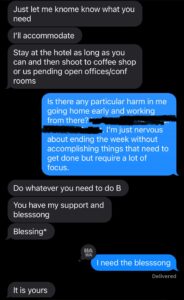Are you overwhelmed with emails? Does your stomach drop when you get a call from work? Have you lost your cool and started fighting people at the 7-11 during one of your late-night ramen noodle runs? It could be burnout.
If you Google “burnout”, you’ll get about 26.5 million results, so you could say it’s a pretty hot topic. For the most part, people want to know what it is, how you get it, and if you can recover from it – so let’s talk about it.
What is job burnout?
Coined in 1974, the concept of burnout was first described by psychologist Herbert Freudenberger as “the extinction of motivation or incentive, especially where one’s devotion to a cause or relationship fails to produce the desired results.”[3] In other words, burnout occurs when exhaustion finally overcomes your ability to spin your wheels. While not a clinical diagnosis on its own, some common symptoms of job burnout include lack of motivation, cynicism, irritability, decreased productivity, and exhaustion – and can be divided further into three subtypes:
Overload Burnout
This is what most people picture when you mention job burnout – an unreasonable set of expectations with an unsustainable pace and inadequate support from leadership.
Under-challenged Burnout
This type of burnout is colloquially called “boredout” because you can become so disengaged and bored with your work that you lose interest and satisfaction in what you’re doing. Is it a creative name? No. But someone with burnout probably came up with it, so let’s be cool about it.
Neglect Burnout
Without a sense of purpose and agency at work, people can feel helpless. Especially during times of great change at agencies, such as following layoffs or restructuring of departments, employees may struggle to feel engaged with their work or like anything they do makes a difference [5]. And can you blame them? In a study by Market Watch, researchers found that 57% of Gen-Z and 42% of millennial employees reported layoff anxiety in 2024 [6].
But burnout is more than stress or anxiety. Workplace burnout is a culmination of chronic symptoms that haven’t been adequately addressed and can no longer be managed by regular rest found in breaks, weekends, and time off work. On an organizational level (for all you corporate overlords out there) you might notice employees being absent more often, missing deadlines, expressing dissatisfaction with their jobs, or lacking focus on tasks and projects. This can affect both the quality and quantity of what a company can offer to its customers and – unfortunately – talk of shareholder values does not seem to restore and reinvigorate a tiring workforce with the same gusto it once (never) did.
The mental and physical effects of burnout are also plain. In the short term, burnout can result in insomnia, restlessness, headaches, upset stomach, and lowered immunity to illness. Left untreated, it can contribute to more serious health problems such as heart disease and mental illness [4]. It’s bleak.
Burnout across industries
Workplace burnout can occur in any field, but there are some more susceptible to stress than others. During the COVID-19 pandemic, we saw healthcare and other frontline workers grapple with the effects of a global virus that inundated hospitals, overwhelmed public servants and redefined how we respond to global disasters. Employees who are expected to extend constant streams of empathy and solutions to their clients are, themselves, extremely vulnerable to burnout.
Compassion fatigue is a different type of burnout entirely. It occurs when the physical, mental, and psychological toll of caring for another’s pain and burdens overwhelms the caregiver to the point of exhaustion [2]. This type of burnout is common among professionals who use their emotions to help others, such as nurses, case workers, therapists, behavioral health technicians, and others.
In the addiction and mental health space, professionals are exposed to this type of burnout regularly. Recovery for addicted populations is an ongoing mission within organizations like Recovery Unplugged, and our staff – while incredible – is made up of human beings with a full and healthy spectrum of emotions. When a client relapses or passes away, it’s felt throughout the company with nurses, counselors, case managers, techs, and alumni coordinators bearing the weight of grief for a life they wanted to see restored. Compounded with organizational stressors, these workers often get a double helping of burnout and have to manage the health of their clients, themselves, and their careers simultaneously.
How to manage burnout?
The best way to manage burnout is to take steps to avoid it entirely. But since you’ve read this far into an article on corporate burnout, let me write something more helpful to your plight.
If you’re feeling stressed and unable to relax at work due to competing demands on your time, try to get organized with an Eisenhower Matrix. This will help you filter what is a priority, what can be delegated, what can be postponed, and what can be removed from your task list completely. Being intentional in your rest time can also help – instead of doom-scrolling or bed-rotting in a dark room watching King of the Hill for the 14th time, limit your screen time and replace it with something meaningful or meditative. This could be exercise (which I am sad to report does, in fact, help tremendously), spending time with loved ones, or immersing yourself in a hobby that brings you peace or joy [7].
But again, this is an article on burnout. Not stress. This is for the knackered, frayed, harrowed, two-shakes-from-a-mental-breakdown-in-front-of-your-boss people. What do those people do?
You’ve got to rest.
Self-care is healthcare. Rest can look like setting boundaries at work, like turning your computer off or leaving the office as soon as your scheduled shift is over. It can be delegating projects to members of your team who have more time and energy to dedicate to them. It can mean taking a few days or even weeks off of work to recenter a life that has gotten away from you – you may even consider therapy to help work through the exhaustive emotions you may be feeling. It could mean reevaluating your employment or company altogether.
With 24% of the population of the United States only two weeks away from running out of money at any given moment, these suggestions might feel outside the realm of possibility, but there are really two options here: Take a break or your body will make you take a break.
During this break, be mindful of activities that fulfill the parts of your life that have been suffering. Are you feeling stagnant? Learn something new. Disenfranchised? Dedicate some time to a cause you feel passionate about. Lonely? Spend time with your community – or create a new one.
In an age of machinery and AI, remember that you aren’t a robot. You’re a living, breathing thing with a wealth of meaningful experiences, and your life doesn’t begin and end with shareholder value.

It’s not just on the employee – looking at you, leadership!
Burnout isn’t failure, it’s feedback – and you should be listening. If your team has recently experienced upheaval, a culture change, or a loss, it’s up to you to lead them into whatever the next chapter of their employment looks like. Checking in on workloads, processes that may need updating, and general employee satisfaction and health goes a long way in reducing stress on your team.
Taking an inventory of the problems and practices within your company can also help you get a clearer picture of what your employees are dealing with. Are they being fairly compensated in the market they’re in? Have they been given opportunities for growth, education, flexibility, or agency in their career? Are they adequately staffed? Do they have the resources they need to perform at the level that is expected of them?
The importance of grace cannot be overstated
In times that are well on their way out the door, the corporate rat race culture prevented employees from expressing dissatisfaction or poor health due to the fear leadership would lose confidence in their ability to function and fire them. The classic 1980s movie trope of the hardworking all-American guy who teams up with a down-on-his-luck street hustler and a heart-of-gold prostitute to bring down the greedy and illegal machinations of the ruling class (shoutout to Trading Places) doesn’t always play out as satisfyingly for the common man, and they may need help they don’t know how to ask for.
If you have an employee who usually outperforms, meets all of their deadlines, and is easy to work with who suddenly starts missing due dates, becomes irritable, or begins socially isolating from your team – I’m begging you to notice. Not only to notice but to consider that rather than becoming complacent or lazy in their roles, they may be under a tremendous amount of pressure that they don’t know how to vocalize. Leaders set the tone for communication in a company. Give grace. No one can heal in the same environment that broke them.
A job for both sides
I love a good corporate snark session but to be real, this is a team effort. Employees and leadership should strive for healthy and inclusive workplaces that allow trust to grow between both parties. Everyone wants to know someone has their back. Discussing workloads or ways to make projects more efficient keeps expectations reasonable and ensures responsibilities are equitable. If restructuring is necessary, don’t be afraid to have that discussion as a team [1].
Sometimes, the solution might be to change job duties or move the employee to a different role within the same company. This could help break any stagnation or dissatisfaction an employee is feeling, while keeping valuable people from leaving an organization altogether. Really a win-win.
An ode to good leadership
Not sure how to cultivate the environment I’m talking about in this article? Here is a text exchange between a manager and an employee, showing just how easy it can be:


























